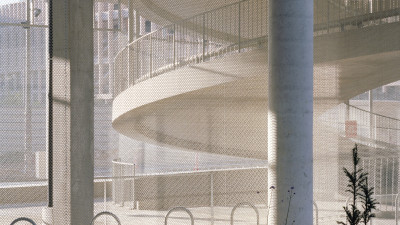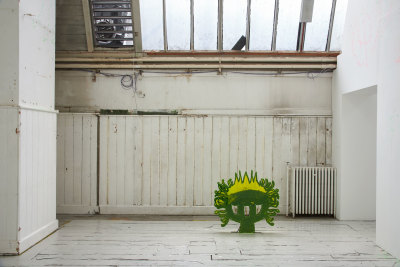Architect Leonard Manasseh at age 100
Architect Leonard Manasseh at age 100
By Timothy Brittain-Catlin
Published 20 May 2016
As Leonard Manasseh becomes our first centenarian Royal Academician, his cousin, the architectural historian Timothy Brittain-Catlin, takes a look at a career of over 80 years.
-
My cousin Leonard Manasseh, who on 21 May becomes the first centenarian in the RA’s history, has maintained a continuous, fresh and lively stream of creativity for over 80 years.
Leonard was born in 1916 in Eden Hall, Singapore in the house of his uncle Ezekiel Manasseh, which is today the residence of the British High Commissioner. The Manassehs were traders from Baghdad, originally in opium but by then in rubber and jute, and, like others with a similar background, Leonard and his sister Sylvia were sent to England to be educated.
Leonard arrived at the Architectural Association School of Architecture in Bedford Square in 1935. It quickly became a central institution in his life, the source of many of his personal and professional friendships and connections as a student, and later as an influential teacher and practicing architect. In 1949 he won a competition for the luxury restaurant at the Festival of Britain, and together with Ian Baker, another AA graduate, established the practice of Leonard Manasseh & Partners. Although the restaurant was downscaled to become the modest ’51 Bar, Leonard’s work (which included the interior decoration and furnishing) was admired and soon led to other commissions. He worked with Sadie Speight on café and shop designs in London, and on an interior for Michael Rosenauer’s Time Life Building in New Bond Street.
-

Leonard Manasseh's family house at Bacon’s Lane, Highgate

Interior of Leonard Manasseh's family house at Bacon’s Lane, Highgate

King’s Lynn Magistrate Office
-
Leonard’s practice continued to design restaurant and bar interiors, but its architectural output mostly comprised private houses and innovative industrial buildings. But in fact two of the most remarkable projects that he designed are the former Rutherford School of 1957–1960 between Lisson Grove and Edgware Road in central London, and the National Motor Museum at Beaulieu. The school, today King Solomon Academy, consists of a very long north-south classroom block and an adjacent assembly hall under a pyramidal roof. The whole complex was beautifully detailed with “boy-proof” marble floors and skirtings, and incorporated works by Hubert Dalwood as well as Leonard’s own sculpture garden and his stained glass in its library. The school was recently extended by Ian Ritchie RA as part of a thorough restoration project.
As it went up, Leonard built for his family, his wife Sarah and children, his own house in Bacon’s Lane, Highgate, which like the school is listed Grade II*. “Courtyards”, one of Leonard’s other remarkable surviving houses, was built for the film director Richard Lester in Petersham in 1964–67. In the mid 1960s Michael Hopkins RA worked as a project architect at the practice. A few years later, in 1979, he was elected a Royal Academician.
-

Beaulieu Motor Museum, designed by Leonard Manasseh RA

Beaulieu Motor Museum, designed by Leonard Manasseh RA
-
Lord Montagu of Beaulieu’s National Motor Museum forms part of a development which rivals the grand landscape schemes of the eighteenth century. Here, together with the architect-planner Elizabeth Chesterton, with whom it frequently collaborated, the Manasseh partnership built the museum itself, a restaurant, a monorail and offices along a 500-metre axis. In fact Leonard and Chesterton were pioneers in designing industrial complexes for sensitive landscapes, including the design of quarry buildings in Somerset and Argyllshire. A long-lasting friendship with the engineer and industrialist Jeremy Fry of Rotork led to some interesting projects: Leonard designed Fry’s offices in Kingswood, and later a large packing area for the firm’s Bath offices, beautifully photographed by Colin Westwood for the Architectural Review in 1968. The Partnership later also specialised in museum and gallery work, designing in 1982 the RA Shop, and the Joseph E. Hotung Gallery at the British Museum of 1992 established a particularly high standard of display.
All through his life Leonard has drawn and painted, and has always contributed to the Summer Exhibition. He adores the Royal Academy just as he adores the Architectural Association – and they both adore him.
-

Leonard Manasseh RA, Design for Radipole Lake pumping station, for Weymouth and Portland Borough Council, Weymouth, Devon: plan, elevation and section, 9 April 1979.
Diploma Work, accepted 1979–80.
Print with black ink, on paper, with pencil, grey, blue and turquoise crayon added and two paper labels, printed with black ink. 83.50 x 98.0 cm. Photo credit: © Royal Academy of Arts, London.
-
Timothy Brittain-Catlin is an architect who has been writing about architectural history, especially early nineteenth-century and early twentieth English architecture, for many years. He teaches at the Kent School of Architecture.









